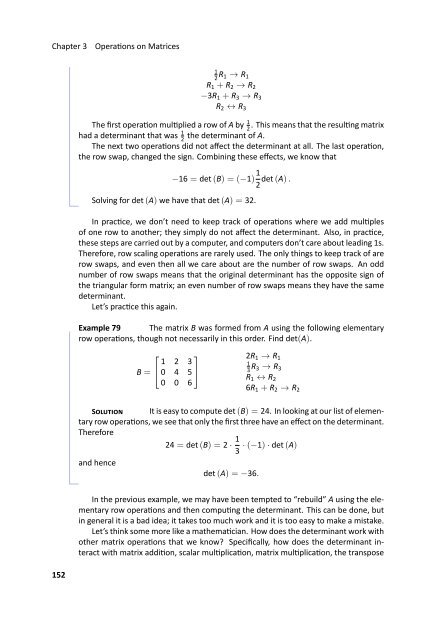Fundamentals of Matrix Algebra, 2011a
Fundamentals of Matrix Algebra, 2011a
Fundamentals of Matrix Algebra, 2011a
You also want an ePaper? Increase the reach of your titles
YUMPU automatically turns print PDFs into web optimized ePapers that Google loves.
Chapter 3<br />
Operaons on Matrices<br />
1<br />
2 R 1 → R 1<br />
R 1 + R 2 → R 2<br />
−3R 1 + R 3 → R 3<br />
R 2 ↔ R 3<br />
The first operaon mulplied a row <strong>of</strong> A by 1 2<br />
. This means that the resulng matrix<br />
had a determinant that was 1 2<br />
the determinant <strong>of</strong> A.<br />
The next two operaons did not affect the determinant at all. The last operaon,<br />
the row swap, changed the sign. Combining these effects, we know that<br />
−16 = det (B) = (−1) 1 det (A) .<br />
2<br />
Solving for det (A) we have that det (A) = 32. .<br />
In pracce, we don’t need to keep track <strong>of</strong> operaons where we add mulples<br />
<strong>of</strong> one row to another; they simply do not affect the determinant. Also, in pracce,<br />
these steps are carried out by a computer, and computers don’t care about leading 1s.<br />
Therefore, row scaling operaons are rarely used. The only things to keep track <strong>of</strong> are<br />
row swaps, and even then all we care about are the number <strong>of</strong> row swaps. An odd<br />
number <strong>of</strong> row swaps means that the original determinant has the opposite sign <strong>of</strong><br />
the triangular form matrix; an even number <strong>of</strong> row swaps means they have the same<br />
determinant.<br />
Let’s pracce this again.<br />
. Example 79 The matrix B was formed from A using the following elementary<br />
row operaons, though not necessarily in this order. Find det(A).<br />
⎡<br />
1 2<br />
⎤<br />
3<br />
B = ⎣ 0 4 5 ⎦<br />
0 0 6<br />
2R 1 → R 1<br />
1<br />
3 R 3 → R 3<br />
R 1 ↔ R 2<br />
6R 1 + R 2 → R 2<br />
S It is easy to compute det (B) = 24. In looking at our list <strong>of</strong> elementary<br />
row operaons, we see that only the first three have an effect on the determinant.<br />
Therefore<br />
24 = det (B) = 2 · 1 · (−1) · det (A)<br />
3<br />
and hence<br />
det (A) = −36.<br />
.<br />
In the previous example, we may have been tempted to “rebuild” A using the elementary<br />
row operaons and then compung the determinant. This can be done, but<br />
in general it is a bad idea; it takes too much work and it is too easy to make a mistake.<br />
Let’s think some more like a mathemacian. How does the determinant work with<br />
other matrix operaons that we know? Specifically, how does the determinant interact<br />
with matrix addion, scalar mulplicaon, matrix mulplicaon, the transpose<br />
152

















